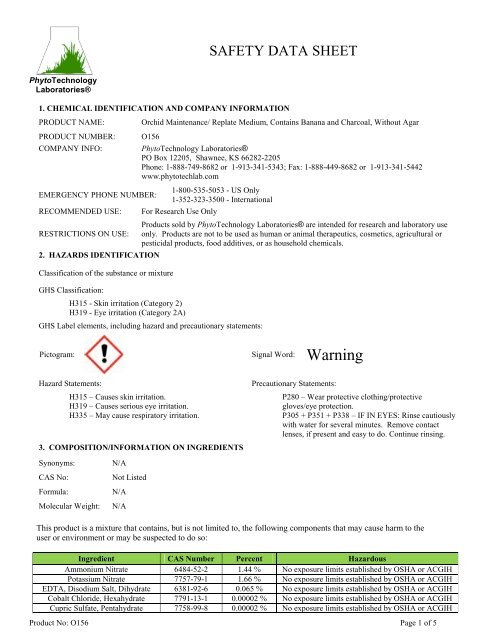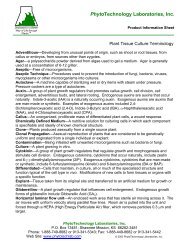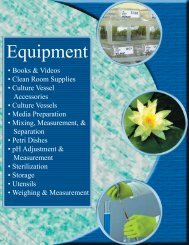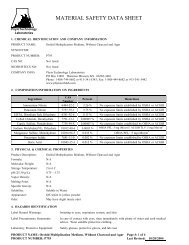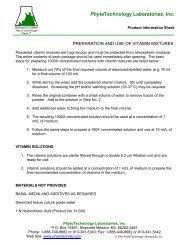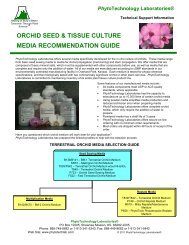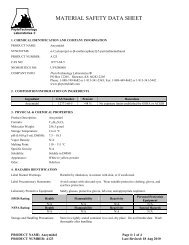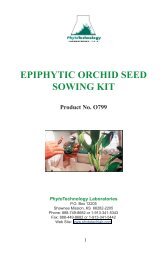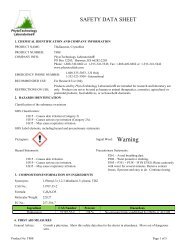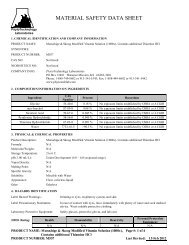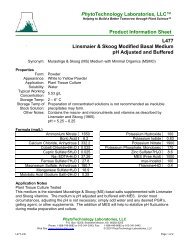MSDS-O156 - PhytoTechnology Laboratories
MSDS-O156 - PhytoTechnology Laboratories
MSDS-O156 - PhytoTechnology Laboratories
You also want an ePaper? Increase the reach of your titles
YUMPU automatically turns print PDFs into web optimized ePapers that Google loves.
SAFETY DATA SHEET<br />
<strong>PhytoTechnology</strong><br />
<strong>Laboratories</strong>®<br />
1. CHEMICAL IDENTIFICATION AND COMPANY INFORMATION<br />
PRODUCT NAME:<br />
Orchid Maintenance/ Replate Medium, Contains Banana and Charcoal, Without Agar<br />
PRODUCT NUMBER:<br />
COMPANY INFO:<br />
<strong>O156</strong><br />
EMERGENCY PHONE NUMBER:<br />
RECOMMENDED USE:<br />
RESTRICTIONS ON USE:<br />
2. HAZARDS IDENTIFICATION<br />
Classification of the substance or mixture<br />
GHS Classification:<br />
<strong>PhytoTechnology</strong> <strong>Laboratories</strong>®<br />
PO Box 12205, Shawnee, KS 66282-2205<br />
Phone: 1-888-749-8682 or 1-913-341-5343; Fax: 1-888-449-8682 or 1-913-341-5442<br />
www.phytotechlab.com<br />
1-800-535-5053 - US Only<br />
1-352-323-3500 - International<br />
For Research Use Only<br />
H315 - Skin irritation (Category 2)<br />
H319 - Eye irritation (Category 2A)<br />
Products sold by <strong>PhytoTechnology</strong> <strong>Laboratories</strong>® are intended for research and laboratory use<br />
only. Products are not to be used as human or animal therapeutics, cosmetics, agricultural or<br />
pesticidal products, food additives, or as household chemicals.<br />
GHS Label elements, including hazard and precautionary statements:<br />
Pictogram: Signal Word: Warning<br />
Hazard Statements:<br />
H315 – Causes skin irritation.<br />
H319 – Causes serious eye irritation.<br />
H335 – May cause respiratory irritation.<br />
3. COMPOSITION/INFORMATION ON INGREDIENTS<br />
Precautionary Statements:<br />
P280 – Wear protective clothing/protective<br />
gloves/eye protection.<br />
P305 + P351 + P338 – IF IN EYES: Rinse cautiously<br />
with water for several minutes. Remove contact<br />
lenses, if present and easy to do. Continue rinsing.<br />
Synonyms:<br />
CAS No:<br />
Formula:<br />
Molecular Weight:<br />
N/A<br />
Not Listed<br />
N/A<br />
N/A<br />
This product is a mixture that contains, but is not limited to, the following components that may cause harm to the<br />
user or environment or may be suspected to do so:<br />
Ingredient CAS Number Percent Hazardous<br />
Ammonium Nitrate 6484-52-2 1.44 % No exposure limits established by OSHA or ACGIH<br />
Potassium Nitrate 7757-79-1 1.66 % No exposure limits established by OSHA or ACGIH<br />
EDTA, Disodium Salt, Dihydrate 6381-92-6 0.065 % No exposure limits established by OSHA or ACGIH<br />
Cobalt Chloride, Hexahydrate 7791-13-1 0.00002 % No exposure limits established by OSHA or ACGIH<br />
Cupric Sulfate, Pentahydrate 7758-99-8 0.00002 % No exposure limits established by OSHA or ACGIH<br />
Product No: <strong>O156</strong> Page 1 of 5
Sodium Molybdate(VI), Dihydrate 10102-40-6 0.0002 % OSHA PEL: 5 mg (Mo)/m 3 ; ACGIH TLV: 5 mg (Mo)/m 3<br />
Manganese Sulfate, Monohydrate 10034-96-5 0.015 % OSHA PEL: 5 mg (Mn)/m 3<br />
Potassium Iodide 7681-11-0 0.0007 % No exposure limits established by OSHA or ACGIH<br />
Boric Acid 10043-35-3 0.005 % No exposure limits established by OSHA or ACGIH<br />
Charcoal 7440-44-0 3.49 % OSHA PEL: 5 mg/m 3 (resp), 15 mg/m 3 (total)<br />
4. FIRST AID MEASURES<br />
General Advice:<br />
Consult a physician. Show this safety data sheet to the doctor in attendance. Move out of dangerous<br />
area.<br />
Route of Entry Symptoms First Aid Procedures<br />
Ingestion May cause irritation if swallowed If swallowed, wash out mouth with water. Never give anything<br />
by mouth to an unconscious person. Get medical attention.<br />
Inhalation<br />
Eye Contact<br />
May cause irritation to respiratory<br />
tract<br />
Direct contact may cause irritation.<br />
May cause redness, tearing, or<br />
blurred vision.<br />
Safely remove victim to fresh air. If not breathing, institute<br />
cardiopulmonary resuscitation (CPR). If breathing is difficult,<br />
ensure clear airway and give oxygen. Get medical attention.<br />
Flush immediately with large amounts of water for at least 15<br />
minutes. Eyelids should be held away from the eyeball to<br />
ensure thorough rinsing. Get medical attention if irritation<br />
persists.<br />
Skin Contact<br />
Irritating. May cause reddening,<br />
itching or inflammation.<br />
Most Important Symptoms or Effects, Both Acute and Delayed:<br />
See section 2 and/or section 11<br />
Recommendation for Immediate Medical Care and Special Treatment Needed:<br />
No data available<br />
Wash area thoroughly with soap and water. Remove and wash<br />
contaminated clothing. Get medical attention if irritation<br />
persists.<br />
5. FIRE FIGHTING MEASURES<br />
Suitable Extinguishing Media:<br />
Special Protective Equipment and<br />
Precaution for Firefighters:<br />
Hazardous Combustion Products:<br />
Toxic Gases Produced:<br />
Water spray, carbon dioxide, dry chemical powder, or appropriate foam. Use<br />
extinguishing media suitable for surrounding fire.<br />
In the event of a fire, wear full protective clothing and NIOSH approved selfcontained<br />
breathing apparatus. Evacuate the area and fight fire from a safe distance.<br />
May emit toxic fumes under fire conditions.<br />
Carbon monoxide, carbon dioxide, nitrogen oxides<br />
6. ACCIDENTAL RELEASE MEASURES<br />
Personal Precautions, Protective Equipment and Emergency Procedures:<br />
Use personal protection recommended in Section 8. Avoid dust formation. Avoid breathing vapours, mist or gas.<br />
Ensure adequate ventilation, especially in confined areas. Evacuate personnel to safe areas. Avoid breathing dust.<br />
Environmental Precautions:<br />
Prevent further leakage or spillage if safe to do so. Do not let product enter drains.<br />
Method of Containment and<br />
Cleanup:<br />
7. HANDLING AND STORAGE<br />
Precaution for Safe Handling:<br />
Conditions for Safe Storage:<br />
Wear suitable protective clothing. Avoid dust formation. Carefully sweep up and<br />
remove. Place material in a dry container and cover. Remove from the area. Flush<br />
spill area with water. Do not let products enter drains.<br />
Avoid contact with skin and eyes. Avoid dust formation and aerosols. Avoid<br />
incompatible substances. Keep away from combustible materials. Wash thoroughly<br />
after use.<br />
Keep in a tightly closed container and store in a cool, dry, and well-ventilated area.<br />
Protect from moisture.<br />
Product No: <strong>O156</strong> Page 2 of 5
Incompatibilities:<br />
Recommended Storage Temperature:<br />
Strong oxidizing agent<br />
2 to 6 o C<br />
8. EXPOSURE CONTROLS/PERSONAL PROTECTION<br />
OSHA’s Permissible Exposure Limits (PELs):<br />
No data available<br />
Threshold Limit Values (TLVs):<br />
Engineering Controls:<br />
Personal Protective Equipment (PPE):<br />
Eye/Face Protection:<br />
Skin Protection:<br />
Body Protection:<br />
No data available<br />
Handle in accordance to general industrial hygiene and safety practice.<br />
Chemical safety glasses or goggles. Have eye-washing facilities readily available where<br />
eye contact can occur.<br />
Protective gloves<br />
Lab coat<br />
Respiratory Protection:<br />
9. PHYSICAL AND CHEMICAL PROPERTIES<br />
Appearance: Gray to Black Powder<br />
pH (57.31 g/L): 4.5 – 5.5<br />
Solubility: Partially Soluble in Water<br />
Melting Range: No data available<br />
Vapor Density: No data available<br />
Vapor Pressure: No data available<br />
Specific Gravity: No data available<br />
Odor:<br />
May have a slight banana odor<br />
Odor Threshold: No data available<br />
Viscosity:<br />
No data available<br />
Relative Density: No data available<br />
Evaporation Rate:<br />
No data available<br />
Initial Boiling Point and<br />
Boiling Range:<br />
No data available<br />
Flammability (solid, gas): No data available<br />
Partition coefficient:<br />
n-octanol/water):<br />
No data available<br />
Auto-ignition Temperature: No data available<br />
Decomposition Temperature:<br />
Flash Point (Closed Cup):<br />
Flammable Limits:<br />
Respiratory protection is not required.<br />
Use N95 (US) or type P1 (EN 143) dust mask where dust level is nuisance.<br />
A NIOSH/MSHA approved air purifying respirator is recommended where airborne<br />
concentrations are expected to exceed exposure limits. Protection provided by purifying<br />
respirators is limited.<br />
No data available<br />
No data available<br />
Upper (%) – No data available<br />
10. STABILITY AND REACTIVITY<br />
Reactivity:<br />
No data available<br />
Chemical Stability:<br />
Possibility of Hazard Reactions:<br />
Conditions to Avoid:<br />
Incompatibles Materials:<br />
Stable under normal conditions of use<br />
Will not occur<br />
Moisture, excessive heat<br />
Strong oxidizing agents<br />
Lower (%) – No data available<br />
Product No: <strong>O156</strong> Page 3 of 5
Hazardous Decomposition Products:<br />
Carbon monoxide, carbon dioxide, and nitrogen oxides<br />
11. TOXICOLOGICAL INFORMATION<br />
Toxicity: LD 50 (Oral-Rat)(mg/Kg): No data available<br />
LD 50 (Oral-Mouse)(mg/Kg): No data available<br />
LD 50 (Dermal-Rabbit)(mg/Kg): No data available<br />
Carcinogenicity: NTP: No<br />
IARC: No<br />
Z List: No<br />
OSHA Reg: No<br />
Reproductive Toxicity:<br />
Symptoms Associated with<br />
Overexposure:<br />
Specific Target Organ<br />
Toxicity:<br />
No data available<br />
Irritation, sneezing, gastrointestinal upset<br />
Single Exposure: No data available<br />
Repeated Exposure: No data available<br />
Target Organs:<br />
Medical Conditions<br />
Aggravated By Exposure:<br />
Routes of Entry:<br />
NIOSH/RTECS NO:<br />
None identified<br />
None identified<br />
Inhalation, Ingestion, skin and eye contact<br />
Not listed<br />
The toxicological properties of this product have not been thoroughly investigated<br />
12. ECOLOGICAL INFORMATION<br />
Ecotoxicity:<br />
Persistence and Degradability:<br />
Bioaccumulative Potential:<br />
Mobility in Soil:<br />
Other Adverse Effects:<br />
No data available<br />
No data available<br />
No data available<br />
No data available<br />
No data available<br />
13. DISPOSAL CONSIDERATION<br />
Disposal Procedure:<br />
Dispose in accordance with all applicable federal, state, and local environmental<br />
regulations.<br />
EPA Hazardous Waste Number:<br />
14. TRANSPORT INFORMATION<br />
No data available<br />
Domestic (D.O.T.): Proper Shipping Name: CHEMICALS, N.O.S. (NON-REGULATED)<br />
International:<br />
Hazard Class:<br />
UN/NA:<br />
Labels:<br />
IMDG: Proper Shipping Name: CHEMICALS, N.O.S. (NON-REGULATED)<br />
Hazard Class:<br />
UN/NA:<br />
N/A<br />
N/A<br />
N/A<br />
N/A<br />
N/A<br />
Product No: <strong>O156</strong> Page 4 of 5
Labels:<br />
N/A<br />
IATA: Proper Shipping Name: CHEMICALS, N.O.S. (NON-REGULATED)<br />
Hazard Class:<br />
N/A<br />
UN/NA:<br />
N/A<br />
Labels:<br />
N/A<br />
15. REGULATORY INFORMATION<br />
TSCA:<br />
No<br />
SARA TITLE III:<br />
Section 302 (EHS) Ingredients:<br />
Section 313 Ingredients:<br />
Section 304 (EHS/CERCLA) Ingredients:<br />
Section 311/312 Hazard:<br />
No<br />
No<br />
No<br />
Acute Health Hazard, Chronic Health Hazard<br />
16. OTHER INFORMATION<br />
HMIS Rating: Health Hazard Chronic Health Hazard Flammability Physical Hazard<br />
2 * 0 3<br />
NFPA Rating: Health Hazard Fire Hazard Reactivity Hazard Special Hazard<br />
2 0 0<br />
*Chronic Hazard: Chronic (long-term) health effects may result from repeated overexposure.<br />
16. OTHER INFORMATION<br />
<strong>PhytoTechnology</strong> <strong>Laboratories</strong>® provides the information contained herein in good faith but makes<br />
no representation as to its comprehensiveness or accuracy. The above information is intended to be<br />
used only as a guide to the appropriate precautionary handling of this material by a properly trained<br />
person. <strong>PhytoTechnology</strong> <strong>Laboratories</strong>® shall not be held liable for any damage resulting from<br />
handling or from contact with the above product. This product is intended for LABORATORY<br />
USE ONLY. Our products may NOT BE USED as drugs, cosmetics, agricultural or pesticidal<br />
products, food additives or as household chemicals.<br />
Revision Date: 22 Sep 14<br />
Product No: <strong>O156</strong> Page 5 of 5


